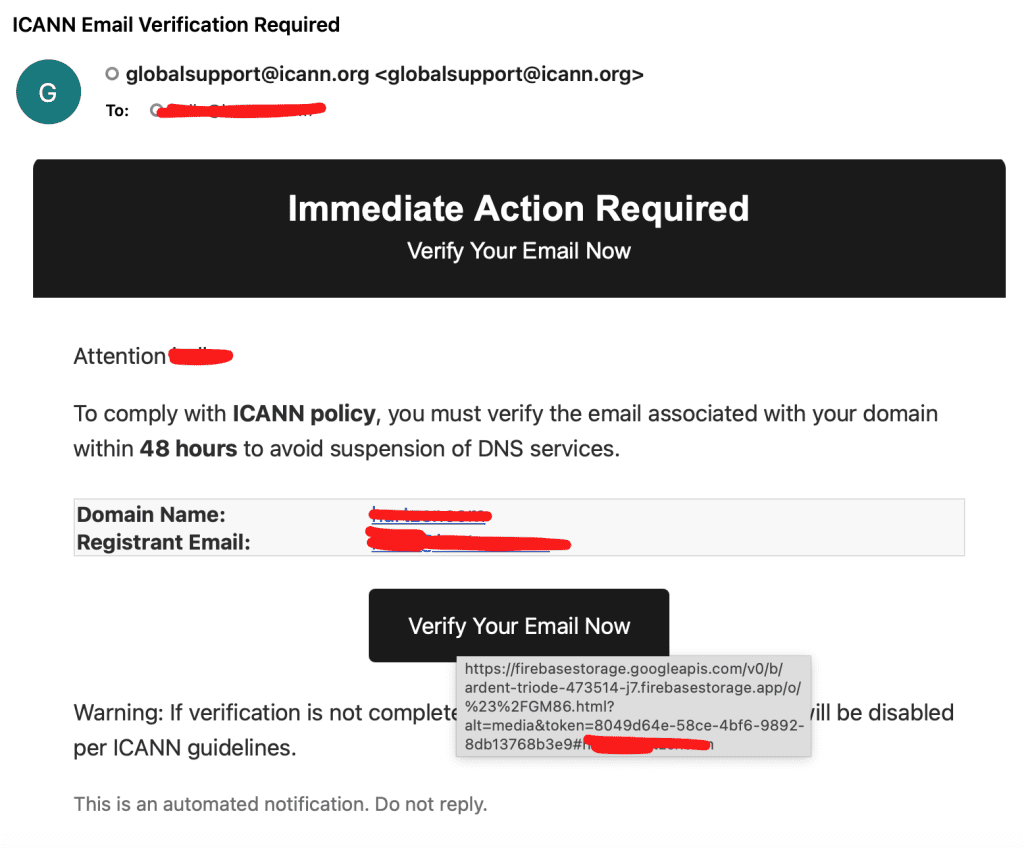
Another round of phishing emails is circulating, and this time the attackers are pretending to be ICANN. The message claims that your DNS services will be suspended if you don’t “verify your email within 48 hours.” It looks official enough to fool many domain owners, which is exactly what these attackers rely on. Their goal is simple: get you to click the link, enter your registrar login, and hand over control of your domain name.
These phishing attempts are dangerous because once a scammer gains access to your registrar account, your domain name can be transferred away in minutes. At DNAccess, we see the results of these attacks every month—business owners who unknowingly clicked a fake verification link and suddenly found themselves locked out of their own domain.
How This Fake ICANN Email Tries to Deceive You
The message looks like a routine ICANN compliance notice. It references “ICANN policy,” mentions a specific domain name, and demands immediate action. But the entire email is fabricated. ICANN does not contact registrants directly about verification. ICANN does not threaten DNS suspension through email. And ICANN does not manage your login credentials.
Your domain registrar handles account verification, and legitimate messages always link back to their official website. Anything else should be treated as suspicious.
Why This Email Was Clearly Fake
The attackers sent their message to an email address I never use for registrar logins or domain administration. This address exists only as a public-facing contact point. If a message arrives with claims about domain verification or DNS access, and it lands in an inbox that has no connection to your registrar, it’s guaranteed to be phishing.
This is why we strongly recommend keeping your public contact email and your private registrar login email completely separate. It’s one of the simplest ways to protect your domain assets.
The Link Reveals the Truth
As with most phishing attempts, the verification link gives it away. Hovering over the button reveals a GoogleAPIs Firebase URL. Scammers frequently use temporary cloud-hosted pages to capture login credentials.
Once they have your username and password, they can lock you out, change the registrant information, or initiate a transfer to another registrar. In many cases, the legitimate owner doesn’t even realize what happened until it’s too late and the domain has moved offshore.
If You Fall for One of These Emails, DNAccess Can Help
Even with precautions, phishing attacks still succeed. We handle stolen domain name cases every day at DNAccess, and many of them start with a fake email just like this one. If you or someone on your team accidentally clicks a fraudulent link and enters account credentials, immediate action is critical.
Our stolen domain name recovery services focus on identifying where the domain was moved, determining the method of theft, gathering evidence, and working directly with registrars and registries to secure its return. The sooner you contact us after the breach, the higher the probability of recovering the domain before it’s resold or transferred again.
What You Should Do Right Away
- Change your registrar password immediately, even if you only clicked the link.
- Enable two-factor authentication for all registrar accounts.
- Check your domain’s transfer lock status.
- Review account access logs for any unauthorized changes.
- If the domain has already been transferred, contact DNAccess as soon as possible.
Every hour matters when dealing with a stolen domain name. Attackers often move quickly, transferring the domain to foreign registrars to complicate recovery. DNAccess has experience working through these cases, conducting forensic analysis, and pushing for fast registrar action based on ICANN policies and contract requirements.
Preventing These Attacks in the Future
Separating your public-facing email from your registrar login email is a major first step. Turn on two-factor authentication, review access logs regularly, and avoid clicking links in unexpected messages.
If anything looks suspicious, don’t rely on the email. Log in directly to your registrar by typing the URL into your browser. Your dashboard will always tell you the truth.
Stay Alert—and If Something Goes Wrong, DNAccess Is Here
Phishing attempts targeting domain owners are becoming more sophisticated, and this fake ICANN verification email is one of the latest examples. Staying aware of these tactics is essential, but having a recovery plan matters just as much. If a domain has been stolen—or if you believe your login credentials were compromised—DNAccess can help you take immediate action.
Your domain name is your business’s identity. We take its security seriously.
